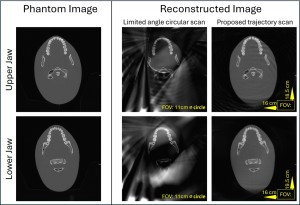Reconstructed Images and Extended Field of View (FOV):
- The FOV for the limited-angle circular scan (in the axial plane) was a circle with a diameter of 11 cm.
- Using the proposed trajectory, the reconstructed volume expanded to approximately 15 cm in cranial breadth and 19.5 cm in the naso-occipital length.
- This represents an FOV increase of approximately 77%.

The following animated graphics provide a comparative illustration of the reconstructed images obtained using limited-angle circular scan data and the proposed fusion trajectory scan data, alongside the phantom image, across different imaging planes (Axial, Coronal, and Sagittal).



Quantitative Analysis of Extended FOV Images: To evaluate the reconstructed images from both the limited-angle circular scan and the proposed fusion trajectory, Peak Signal-to-Noise Ratio (PSNR) and Structural Similarity Index Measurement (SSIM) scores were calculated by comparing them to the digital phantom image.
- PSNR: This metric indicates the accuracy of image reconstruction. A PSNR value of 30 dB or higher is considered indicative of good reconstruction relative to the ground truth.
- SSIM: This metric assesses the visual quality of the image. Values closer to 1.00 represent better visual similarity to the ground truth.
- Results: Images reconstructed using the proposed fusion trajectory achieved higher PSNR and SSIM scores, demonstrating superior reconstruction quality and visual fidelity compared to those from the limited-angle circular scan.
The following table presents the PSNR and SSIM metric scores for the reconstructed images of the upper and lower jaw volumes, comparing the limited-angle circular scan and the proposed fusion trajectory scan.
